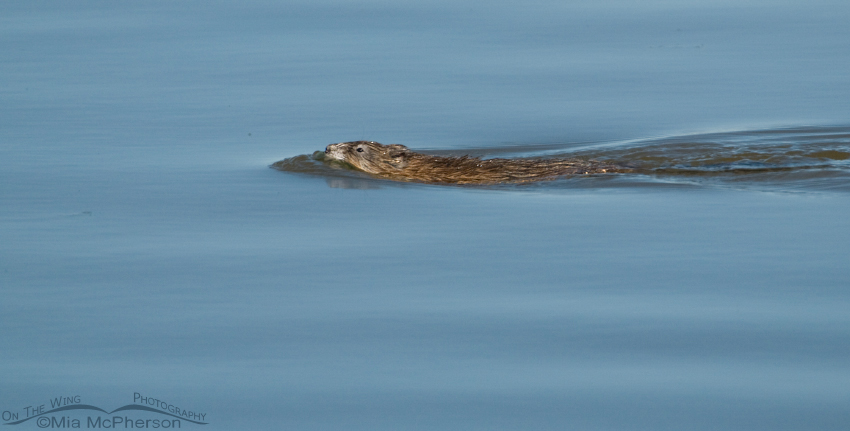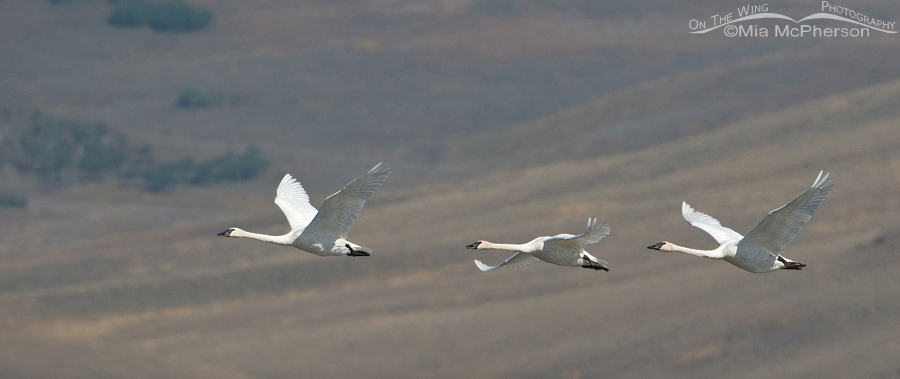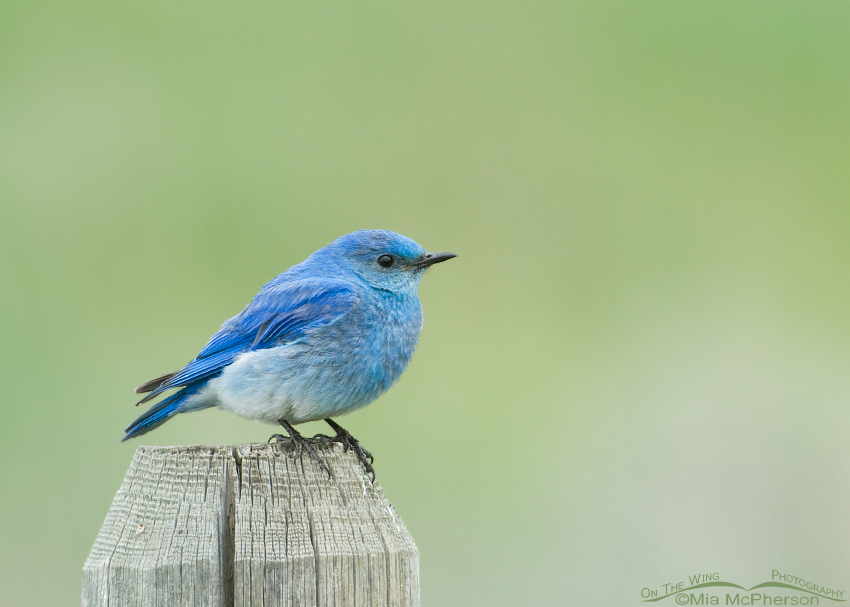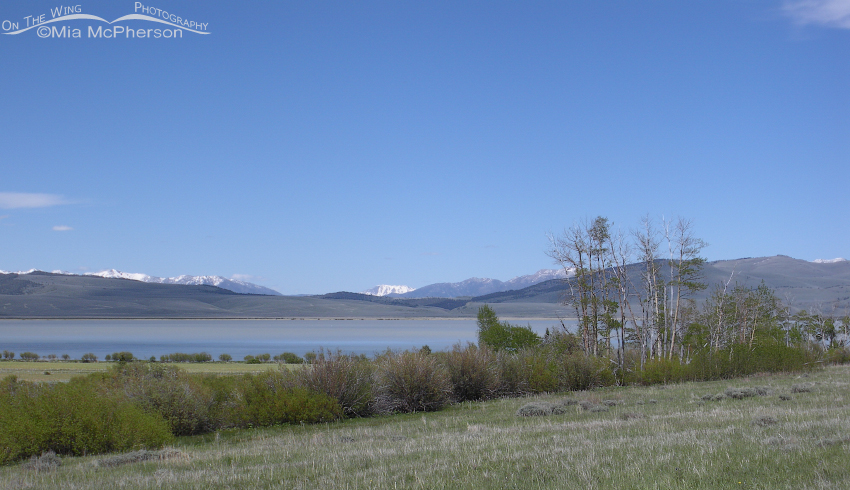Another one of my favorite avian photography locations is Red Rock Lakes National Wildlife Refuge in southern Montana. I’ve been there twice this year since mid-June and I eagerly await returning to this wild and lovely refuge. It is yet another location where I feel at “home”.
As crazy as it may sound, every time I visit the state of Montana I feel taller. I can’t explain why I feel that way, I just do. Perhaps it is because of the “Big Sky” Montana is so well known for. I won’t spend much time trying to figure that out while I am there though because I’d much rather use my time to savor and photograph the incredible beauty found within and outside of the refuge.
 Pronghorn on the gravel road to Red Rock Lakes NWR – Nikon Coolpix s550, f3.5, 1/447, ISO 64, 6mm, natural light, taken through vehicle window
Pronghorn on the gravel road to Red Rock Lakes NWR – Nikon Coolpix s550, f3.5, 1/447, ISO 64, 6mm, natural light, taken through vehicle window
Getting to the Red Rock Lakes NWR from the west can be quite an adventure when the 29 mile gravel road is dry. Let me tell you that driving on it when it has rained or the road is wet can be nerve wracking, slippery and it will seem twice as long. Driving it through fog can be too as you never know what might jump out of the heavy fog onto the road. A Moose, an Elk, Pronghorn or even a bear. From I-15 at the tiny town of Monida you will enter the Centennial Valley driving east and to the south you will see the rugged beauty of the Centennial Mountains.
 A strange old barn seen on the road to Red Rock Lakes NWR from the west – Nikon Coolpix S550, f5.3, 1/380, ISO 64, 21mm, natural light
A strange old barn seen on the road to Red Rock Lakes NWR from the west – Nikon Coolpix S550, f5.3, 1/380, ISO 64, 21mm, natural light
Along the way while making the 29 mile drive from Monida, you will see homesteads and ranches, some livable and some in ruins. One of my favorites is the collapsing old barn in the picture above. I don’t recall ever seeing a barn quite like it. It appears to have a central part, then four smaller parts on each of the four sides. I wonder about the history of this barn and the people who built and used it. I just know when I see it that I smile because it is still there, it hasn’t fallen completely down yet. (This amazing barn was torn down the summer of 2014, I no longer smile when I see where it used to be)
 Lupines blooming in June on a mountain meadow – Nikon Coolpix S550, f3.5, 1/734, ISO 64, 6mm, natural light
Lupines blooming in June on a mountain meadow – Nikon Coolpix S550, f3.5, 1/734, ISO 64, 6mm, natural light
For flora photographers springtime would be great, lupines are just one of the flowers that seem abundant there. At the lower lake campground I was delighted to see Shooting Star Flowers in large numbers, the sunny dandelions heads and more. Birds will always get my attention first but it is hard to ignore those wildflowers or the soft rustling of the various reeds and grasses in the breeze. Or the pungent, pleasing aroma of the sagebrush.
At the west end of the gravel road look for Ferruginous Hawks, the ones I have seen have been down on the ground, perched on a poles, fence posts or wire. You’ll also catch glimpses of American Kestrels hovering overhead while looking for prey, or perhaps hear the cry of a Bald or Golden Eagle or Red-tailed Hawks soaring overhead.
 Sign at the entrance to Red Rock Lakes, NWR – Nikon Coolpix S550, f5.6, 1/250, ISO-78, 32mm, natural light
Sign at the entrance to Red Rock Lakes, NWR – Nikon Coolpix S550, f5.6, 1/250, ISO-78, 32mm, natural light
After this sign (driving from Monida) you enter the Red Rock Lakes National Wildlife Refuge and there is a road to the lower lake campground. The refuge was created in 1935, has been designated as a National Natural Landmark and in 1976 the creation of the Red Rock Lakes Wilderness comprised of 32, 350 acres ensures that no further human development will happen on the bulk of refuge land.
 Be Bear Aware sign at Red Rock Lakes, NWR – Nikon Coolpix S550, f5.6, 1/249, ISO 80, 32mm, natural light
Be Bear Aware sign at Red Rock Lakes, NWR – Nikon Coolpix S550, f5.6, 1/249, ISO 80, 32mm, natural light
Across the road from the refuge entrance sign there is one more sign. I haven’t seen a bear on or near the refuge yet but I pay close attention to the “Be Bear Aware” signs, I am careful about food storage and keep my eyes out for the hulking forms of Black Bears. Grizzly Bears too. Wolves have also been reported in the area so it pays to be aware of the large predators in the area. Mornings, which are often very special on the refuge are made even more spectacular by the sounds of calling Coyotes. There might be people who don’t like that sound, but I love it.
 A view looking slightly south and east of the Red Rock Lakes NWR lower lake campground – Nikon Coolpix S550, f3.5, 1/786, ISO 64, 6mm, natural light
A view looking slightly south and east of the Red Rock Lakes NWR lower lake campground – Nikon Coolpix S550, f3.5, 1/786, ISO 64, 6mm, natural light
Spring comes later in the Centennial Valley than it does here in Utah; in June at the refuge there was a riot of color from the wildflowers and the grasses formed lush carpets of green that encroach the shorelines of the lakes. The willows must be tasty then because you can see Shiras Moose in the willows along the creeks.
 A very young Pronghorn in June with an adult – D200, f6.3, 1/250, ISO 400, EV +0.3, 200-400mm VR with 1.4x TC at 400mm, natural light
A very young Pronghorn in June with an adult – D200, f6.3, 1/250, ISO 400, EV +0.3, 200-400mm VR with 1.4x TC at 400mm, natural light
It is also a time when the young of many animals can be seen, one of my favorites are the young pronghorns, they appear to be delicate though they can run like the wind to keep up with the adults and to escape predators. Besides they are just so cute.
 Female Short-eared Owl at her nest – D200, f5.6, 1/200, ISO 640, EV +0.3, 200-400mm VR with 1.4x TC at 400mm, natural light
Female Short-eared Owl at her nest – D200, f5.6, 1/200, ISO 640, EV +0.3, 200-400mm VR with 1.4x TC at 400mm, natural light
Many birds nest on the refuge, at least 100 species have been documented. This female Short-eared Owl has her nest under the sagebrush near the lower lakes campground, she had several chicks there but the sagebrush camouflages them well.
 Male Short-eared Owl bringing food to the nest – D200, f5.6, 1/640, ISO 640, 200-400mm VR with 1.4x TC at 400mm, natural light, not baited
Male Short-eared Owl bringing food to the nest – D200, f5.6, 1/640, ISO 640, 200-400mm VR with 1.4x TC at 400mm, natural light, not baited
The male Short-eared Owl did the hunting for voles to feed the chicks, he would fly into a perch with the food grasped in his talons and once he was on the perch he would transfer the prey to his beak then fly into the nest to hand off the food to the female. He seemed almost afraid to get too close to the chicks, I believe that was in part due to the aggressive nature of the female at the nest.
 Daylight moonrise over Red Rock Lakes NWR – D200, f8, 1/180, ISO 320, tripod mounted, EV +1.7, 200-400mm VR with 1.4x TC at 400mm
Daylight moonrise over Red Rock Lakes NWR – D200, f8, 1/180, ISO 320, tripod mounted, EV +1.7, 200-400mm VR with 1.4x TC at 400mm
The skies over Red Rock Lakes NWR are mesmerizing, day or night. You can see for miles. At night the black velvet skies are filled with stars, you won’t ever see them as clearly in a city as you can out there in the wide open valley. I haven’t experimented much with night time photos but I’m going to try my next time there.
 Muskrat swimming in the lower lake – D200, f6.3, 1/1600, ISO 320, 200-400mm VR with 1.4x TC at 400mm, natural light
Muskrat swimming in the lower lake – D200, f6.3, 1/1600, ISO 320, 200-400mm VR with 1.4x TC at 400mm, natural light
Along the shore of the lower lake you might come across a Great Blue Heron hunting, or coots nibbling on underwater vegetation, waterfowl making a racket or a muskrat gliding through the water.
 Trumpeter Swans in flight over the lower lake of Red Rock Lakes NWR – D200, f7.1, 1/1600, ISO 400, EV -0.3, 200-400mm VR with 1.4x TC at 400mm, natural light
Trumpeter Swans in flight over the lower lake of Red Rock Lakes NWR – D200, f7.1, 1/1600, ISO 400, EV -0.3, 200-400mm VR with 1.4x TC at 400mm, natural light
One of the birds that Red Rock Lakes NWR is very well known for is the Trumpeter Swan. In the early 1930’s Trumpeter Swans were in extreme danger of becoming extinct, they were over hunted for game and for their feathers. Due to conservation measures since the 1930’s we still have these swan’s today. It is our largest native waterfowl weighing in between 22 and 26 pounds with an average wingspan of 6.7 feet. The trumpeting call of these swan’s is unmistakable.
 Mountain Bluebird male in low light at Red Rock lakes NWR – D200, f6.3, 1/320, ISO 400, EV +0.3, 200-400mm VR with 1.4x TC at 400mm, natural light
Mountain Bluebird male in low light at Red Rock lakes NWR – D200, f6.3, 1/320, ISO 400, EV +0.3, 200-400mm VR with 1.4x TC at 400mm, natural light
Heading from the lower lake campground and driving towards the refuge headquarters look for Mountain Bluebirds on the fence posts. They are very numerous in the refuge but challenging to photograph because they are skittish.
 Savannah Sparrow on a fence post – D200, f5.6, 1/350, ISO 400, EV +0.3, 200-400mm VR with 1.4x TC at 400mm, natural light
Savannah Sparrow on a fence post – D200, f5.6, 1/350, ISO 400, EV +0.3, 200-400mm VR with 1.4x TC at 400mm, natural light
During the summer months you might also see Savannah Sparrows on the fence posts singing. Or in marshy areas a Wilson’s Snipe, you just never know.
 A lovely banner on a wooden building near Red Rock Lakes NWR Headquarters – Nikon Coolpix S550, f4, 1/250, ISO 91, 8mm, natural light
A lovely banner on a wooden building near Red Rock Lakes NWR Headquarters – Nikon Coolpix S550, f4, 1/250, ISO 91, 8mm, natural light
Near the refuge headquarters I spotted this banner on a wooden building and had to stop to take some photos of it. Each animal, bird and design appears to be lovingly hand painted. It is really interesting and well done.
 Herd of Elk just west of the upper lake at Red Rock Lakes NWR – D200, f5.6, 1/350, ISO 400, EV +0.3, 200-400mm VR with 1.4x TC at 400mm, natural light
Herd of Elk just west of the upper lake at Red Rock Lakes NWR – D200, f5.6, 1/350, ISO 400, EV +0.3, 200-400mm VR with 1.4x TC at 400mm, natural light
In between the upper and lowers lakes at Red Rock Lakes NWR there are some wide, flat grassy areas where you might see large herds of Elk. There are also Mule deer on the area that sometimes graze along with the cattle there in the summer.
 A view of the upper lake at Red Rock Lakes NWR – Nikon Coolpix S550, f4.6, 1/570, ISO 64, 11mm
A view of the upper lake at Red Rock Lakes NWR – Nikon Coolpix S550, f4.6, 1/570, ISO 64, 11mm
The upper lake is every bit as stunning to view as the lower lake and has more trees in close proximity to the shoreline. You might find more Trumpeter Swan pairs feeding together, an Eagle high in the trees or see huge flocks of waterfowl and pelicans resting on the surface of the lake.
 Mountain view from the upper lake at Red Rock Lakes, NWR – Nikon Coolpix S550, f3.5, 1/520, ISO 64, 6mm, natural light
Mountain view from the upper lake at Red Rock Lakes, NWR – Nikon Coolpix S550, f3.5, 1/520, ISO 64, 6mm, natural light
Looking south from the upper lake there are the rugged shapes of the Centennial Mountains, with snow remaining up high well past the middle of June. These mountains feed the creeks and lakes of the valley with spring melt.
 A pano view of Red Rock Creek
A pano view of Red Rock Creek
Red Rock Creek on the east side of the upper lakes meanders through grasslands and the banks of it are often lined with willows, it is very picturesque, the mountains and clouds framing a picture postcard view.
 Yellow-bellied Marmot east of the upper lake in the foothills – D200, f6.3, 1/350, ISO 400, 200-400mm VR with 1.4x TC at 400mm, natural light
Yellow-bellied Marmot east of the upper lake in the foothills – D200, f6.3, 1/350, ISO 400, 200-400mm VR with 1.4x TC at 400mm, natural light
This Yellow-bellied Marmot was photographed from a narrow road that goes to Mac Donald Pond on the refuge. You can also see chipmunks scurrying along the road, sitting on lichen covered rocks and peering out from behind sagebrush leaves. High on the hills in old dead snags you might see a Swainson’s Hawk looking over the valley floor. On Mac Donald or Wigeon Pond you might see many species of ducks or small flocks of migrating shorebirds.
 Young Pronghorn born earlier in the year – D200, f5.6, 1/750, ISO 400, 200-400mm VR with 1.4x TC at 220mm, natural light
Young Pronghorn born earlier in the year – D200, f5.6, 1/750, ISO 400, 200-400mm VR with 1.4x TC at 220mm, natural light
Heading back to the campsite on this last trip I had the opportunity to photograph this young Pronghorn that was born earlier this year. They sure grow fast. At this point they were still traveling with the adults and they have begun to form loose herds with a single male close by.

As an avian photographer I am always looking for the opportunity to photograph birds in unusual poses, beautiful settings and in all kinds of light. The light can change very rapidly at Red Rock Lakes NWR, the weather conditions can too. I was thrilled to find this female Short-eared Owl in the early morning with fog swirling in the air as the sun rise tried to burn through.
 Stormy skies with brilliant late afternoon light below at the lower lake campground of Red Rock Lakes NWR – Nikon Coolpix S550, f3.5, 1/250, ISO 125, 6mm, natural light
Stormy skies with brilliant late afternoon light below at the lower lake campground of Red Rock Lakes NWR – Nikon Coolpix S550, f3.5, 1/250, ISO 125, 6mm, natural light
If you have never been to Red Rock Lakes National Wildlife Refuge and decide to go, whether you are a photographer, a bird watcher or a nature lover you will lose a bit of your heart to this incredibly wonderful place. I know I did.
Life is good.
Mia
You can view all of my images taken at Red Rock Lakes National Wildlife Refuge in chronological order, from the newest to the oldest. There are animals, wildflowers, scenic views and of course, my favorites, the birds.


Thank you for sharing especially sharing your camera settings. I’m just getting into photography and it truly helps to see what others use for settings. We are going to be in Montana around the middle/end of October and was thinking of visiting this area, do you know what the weather and roads will be like during that time? I truly enjoy your pictures and journaling, fell in love with Montana and this will be our 5th year going out there, just so much to see!!
Kelly, I belong to a nature photography critique forum and I remember how much it helped me to see what camera settings other photographers used, what worked and what didn’t so I like to include those under my images to hopefully help other photographers.
I would be concerned most about the weather if I were to visit Red Rock Lakes in October. It can go from clear to raining very quickly there during the summer which turns the roads into mud. In October it could snow there and that could make the roads treacherous. Once it rained very hard the night before we left the campground to head to I-15 hauling the trailer, it was nerve wracking because the mud kept making us slide around. This year the roads have been in good condition but rain or snow could change that rapidly.
The other thing is that October is hunting season so it might be busy with hunting going on. I enjoy the quiet at Red Rock Lakes and I am not sure I’d enjoy the sound of guns going off. Usually mid-September is when I stop going up to the Refuge.
Montana is easy to fall in love with and I haven’t seen it all!
Let me know what your experience is like if you do go in October?
Thank you so much for visiting my blog and for your kind words on my work!
Hi, Mia. Just a note of appreciation for your work. I loved the series on Red Rocks, where I pulled up along side you while you and Ron Dudley photographed the raven nest near Widgeon Pond. Nice to meet you both. Best regards. CT
Hi Carl,
Thanks so much for visiting my blog & galleries. It was wonderful meeting you that evening at Red Rocks near the Raven nest, on Tuesday those chicks looked like they could fledge any day! I hope you will stay in touch and perhaps we will see you at Red Rocks again soon!
Mia,
Thank you for these clear, breathtaking photos. I want to visit this place if at all possible.
My daughter and I are reading E. B. White’s The Trumpet of the Swan. Your photos enriched our understanding of the book greatly. I am grateful!
Lori Williams
Lori, thanks for your comment on my images, Red Rock Lakes NWR is a breath taking location. The Swans there are awesome and I think you and your daughter would love a visit there!
Hi, Mia. Love your photos. I see you photographed this mountain bluebird. Do you have other bluebird shots, including Eastern? Would love to see some if so. Thanks for your fabulous site.
Jennifer, thanks for visiting my blog and for your kind comments. I do have more Mountain Bluebird images that I haven’t gotten around to editing but I don’t have any of the Eastern Bluebirds.
Your photographs are so beautiful! I’ve only visited the Avian and Favorites category. I’ll be back for more!
Hope to see you at the workshop with GSLA in February.
Best regards,
Kris
Nice work. How cool to find the owl’s. Did you know they were there, or did
Wonderful collection Mia. Excellent Blog.